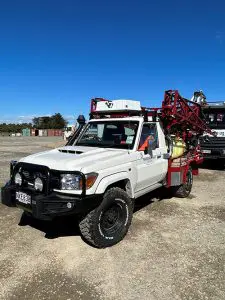Fine inhalable dusts and possibly hazardous fumes are present during work in, for example, demolition, remediation, mining, waste metal processing. Workers can become ill by inhaling these substances and/or vapors. With Freshfilter’s protective ventilation systems, only filtered, thus clean air is blown into the cabin. For a healthy working environment, choose Freshfilter.
A healthy workplace is essential
Through inhalation, fine dust enters the nose, upper and lower airways and lungs. The smaller the diameter of the dust, the deeper it enters the lungs. Ultrafine dust can penetrate as far as the alveoli and be absorbed into the blood. In the lungs, fine dust can cause inflammatory reactions and make oxygen uptake more difficult. Accumulation of this dust can lead to damage to lung cells which can result in lung cancer.
Toxic fumes also pose a danger to a machinist. This danger not only lurks in soil that is contaminated, but can also develop in the waste industry, for example. Depending on the type of waste, the presence of water, temperature and nutrients can create various chemical compounds and microorganisms (such as viruses, fungi).
Safety First
The nature and degree of exposure to particulate matter and vapors determines whether actions should be taken. Although each employee has his or her own responsibility, employers have a duty to provide a safe workplace by identifying, evaluating, and taking appropriate protective measures of occupational hazards. The risk of health effects is lower when working outdoors than in a room because of mixing with clean air. In a cab of a shovel, for example, the concentration of substances and vapors can be much higher than the concentration outside a cab. The workplace inside a machine therefore presents an increased risk of long-term health problems.
Refreshing clean air in an enclosed space (such as a cabin) is necessary to reduce the increased risk of health problems. A suitable means on machines or other enclosed spaces is a protective ventilation systems. To prevent contaminated outside air from entering the cab or other enclosed space, an artificial (but relatively small) pressure is created in the cab so that all air flows out through the remaining gaps. The air required for this overpressure is always passed through the filter package so that it is safeguarded from contaminants and hazardous substances.
 A protective ventilation system from Freshfilter consists of the filter system, an in-cab controller and optional an in-cab recirculation unit. The controller will automatically start up and immediately controll the protective ventilation system in the most optimal settings. In case of possible danger, the controller will directly warn the operator optically and acoustically.
A protective ventilation system from Freshfilter consists of the filter system, an in-cab controller and optional an in-cab recirculation unit. The controller will automatically start up and immediately controll the protective ventilation system in the most optimal settings. In case of possible danger, the controller will directly warn the operator optically and acoustically.
Freshfilter and dealers all over the world have qualified personnel to advice and optimally install a protective ventilation system. Freshfilter specialists invest time in you, asking and answering questions, learning your business, understanding what harmful substances are present so a recommendation can be made. Providing the correct option guarantees a safe and healthy work environment for your team.
After selecting the most optimal system and filter combination, the system is installed on the machine. An installation is not limited to placing the system, but a correct sealing on a machine is of great importance. A cabin should be optimally sealed to create positive pressure and to minimize airflow. Low airflow benefits the lifetime of the protective ventilation system as well as the installed filters. In fact, dust will not attracted into the system due this low air velocity.
A protective ventilation system is connected to the original HVAC, if possible. This ensures that air is blown conditioned into the cabin, it also prevents annoying air flows in the cabin. To connect a system to the HVAC, custom stainless steel connection parts are commonly used. Freshfilter’s experience with ISO regulations, international law, and regional legislation dramatically enhances efficiency with partners and dealers. By collaborating with local Freshfilter entities abroad we’re able to quickly map out compliant products that deliver local solutions from local suppliers.
A standard Freshfilter installation meets the most stringent requirements available, so it can be deployed in any environment.
Some standard features include:
- Overpressure in the cabin is above 100 Pa (standard 115 Pa) and below 300 Pa (with a flow between 40-120m3/h).
- Automatic control controller, incl. filter detection, current pressure display and alarm in case of possible danger.
- Expandable with sensors (such as HC, NH3 and CO) with alarms for potential danger.
- Expandable with in-cab recirculation unit with HEPA 13 filtration level (EN1822).
- Filters supplied according to EN1822 (dust filters) and EN12931/EN14387 (carbon filters).
